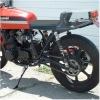Air jets on '76 KZ400 carbs
- Lord_Verminaard
-
 Topic Author
Topic Author
- Offline
- User
-

Registered
- Posts: 12
- Thanks: 0
Air jets on '76 KZ400 carbs
23 Oct 2015 03:10
Hi all, multi-part question that hopefully I can get straightened out with some help from people that know more than I do. I rebuilt the carbs on my project KZ400, they are the original Kehin CVB36 carbs, (with the metal piston slides)
On the top after removing the slide, there is a plate and gasket with a single screw holding it on that covers the air jets. Which jet is witch? I had disassembled the carbs a long time ago so when it came time to re-assemble them I had to go on the parts diagram in the manual, which just shows the two jets in their locations as one jet as being the "slow" jet and one being the "fast" jet. In the specs on kz400.com, it lists a main air jet and a secondary air jet, the main being a 60 and the secondary being a 90. I assumed that the 60 was the slow jet and the 90 was the "fast" jet. Is that assumption correct? They can be interchanged so I wasn't sure if I had them in the correct locations, or if it even mattered.
The issue I am having is that the bike will start fairly easily, run ok, rev very quickly, but any time I blip or raise the RPM's, it takes a long time for the idle to settle back down. It took a lot of fooling with the bike to get it to idle somewhat normally, I have the idle screw turned in (opening) quite far, probably 3 or 4 whole turns after the screw starts to open the butterfly. I also had to go out about 2 1/2 turns on the pilot screw to maintain this idle, and it smells pretty rich at idle as well. Ignition timing is spot on, however I need to verify correct cam chain tension. I have not had a chance to ride the bike yet after re-assembly, kinda wanted a little more stable carb operation before I went on a shakedown run. Carb boots are new, cables are adjusted correctly and not frayed.
Maybe related, maybe not, but I've had the carbs off about 4 times since initial start-up due to leaks. I think 3 of those times it was the fuel lines I was using, once was a bowl gasket that had slipped out. The right side carb is leaking again and I am not sure where or how, everything is new. I don't know what the float level is either, I don't have the tool to measure it.
I have the carbs pulled again and just received a 6-sigma jet kit "customized" to my specifications, which includes slight head porting, MAC 2-2 exhaust and UNI pods on extended velocity stacks. So I figured while they are out, I can try to make sure the air jets are correct, make a tool to set the float level (can you do this on the bench?) and hope they don't leak when I put them back on. (and if the bike runs well, even better!)
Any advice is appreciated. I have worked with carbs a lot but I still am not comfortable messing with them and I get frustrated easily.
Thanks!
Brendan
On the top after removing the slide, there is a plate and gasket with a single screw holding it on that covers the air jets. Which jet is witch? I had disassembled the carbs a long time ago so when it came time to re-assemble them I had to go on the parts diagram in the manual, which just shows the two jets in their locations as one jet as being the "slow" jet and one being the "fast" jet. In the specs on kz400.com, it lists a main air jet and a secondary air jet, the main being a 60 and the secondary being a 90. I assumed that the 60 was the slow jet and the 90 was the "fast" jet. Is that assumption correct? They can be interchanged so I wasn't sure if I had them in the correct locations, or if it even mattered.
The issue I am having is that the bike will start fairly easily, run ok, rev very quickly, but any time I blip or raise the RPM's, it takes a long time for the idle to settle back down. It took a lot of fooling with the bike to get it to idle somewhat normally, I have the idle screw turned in (opening) quite far, probably 3 or 4 whole turns after the screw starts to open the butterfly. I also had to go out about 2 1/2 turns on the pilot screw to maintain this idle, and it smells pretty rich at idle as well. Ignition timing is spot on, however I need to verify correct cam chain tension. I have not had a chance to ride the bike yet after re-assembly, kinda wanted a little more stable carb operation before I went on a shakedown run. Carb boots are new, cables are adjusted correctly and not frayed.
Maybe related, maybe not, but I've had the carbs off about 4 times since initial start-up due to leaks. I think 3 of those times it was the fuel lines I was using, once was a bowl gasket that had slipped out. The right side carb is leaking again and I am not sure where or how, everything is new. I don't know what the float level is either, I don't have the tool to measure it.
I have the carbs pulled again and just received a 6-sigma jet kit "customized" to my specifications, which includes slight head porting, MAC 2-2 exhaust and UNI pods on extended velocity stacks. So I figured while they are out, I can try to make sure the air jets are correct, make a tool to set the float level (can you do this on the bench?) and hope they don't leak when I put them back on. (and if the bike runs well, even better!)
Any advice is appreciated. I have worked with carbs a lot but I still am not comfortable messing with them and I get frustrated easily.
Thanks!
Brendan
Please Log in or Create an account to join the conversation.
- Patton
-

- Offline
- KZr Legend
-

Registered
- Posts: 18568
- Thanks: 2103
Re: Air jets on '76 KZ400 carbs
23 Oct 2015 05:33 - 23 Oct 2015 05:49If not already done, would test for air leak(s) in carb holders, vac plugs, clean air system if applicable, etc.Lord_Verminaard wrote: . . . The issue I am having is that the bike will start fairly easily, run ok, rev very quickly, but any time I blip or raise the RPM's, it takes a long time for the idle to settle back down. . . .
Good Fortune!
1973 Z1
KZ900 LTD
KZ900 LTD
Last edit: 23 Oct 2015 05:49 by Patton.
Please Log in or Create an account to join the conversation.
- loudhvx
-

- Offline
- KZr Legend
-

Registered
- Posts: 10864
- Thanks: 1619
Re: Air jets on '76 KZ400 carbs
23 Oct 2015 05:36
These are some notes I had from 10 years ago working on a 76 KZ400 S2.
...
Pilot air jet: Small stubby screw-in type jet that goes in the top of the carb.
Main air jet: Small stubby screw-in type jet that goes in the top of the carb.
note: the main air jet has a smaller orifice than the pilot air jet.
From the top, the main air jet and pilot air jet can be swapped accidently.
The main air jet goes between the pilot air jet and the screw that holds the plate.
Typically, the numbers represent the diameter of the orifice in hundredths of millimeters.
...
1981 KZ550 D1 gpz.
Kz550 valve train warning.
Other links.
Kz550 valve train warning.
Other links.
The following user(s) said Thank You: Lord_Verminaard
Please Log in or Create an account to join the conversation.
- Lord_Verminaard
-
 Topic Author
Topic Author
- Offline
- User
-

Registered
- Posts: 12
- Thanks: 0
Re: Air jets on '76 KZ400 carbs
23 Oct 2015 06:16
Loudhvx, hot damn, that is exactly what I needed. So it sounds like I have them reversed.
Woo hoo, thanks very much, hopefully I have time to fiddle with it this weekend. I'll reply back after once it's done.
Thanks again,
Brendan
Woo hoo, thanks very much, hopefully I have time to fiddle with it this weekend. I'll reply back after once it's done.
Thanks again,
Brendan
Please Log in or Create an account to join the conversation.
- loudhvx
-

- Offline
- KZr Legend
-

Registered
- Posts: 10864
- Thanks: 1619
Re: Air jets on '76 KZ400 carbs
23 Oct 2015 06:37
I hope that's right. That's how the carbs were when we first got the bike.
We rejetted it for pod filters and it worked out well. The piston carbs are not too bad for jetting for pods, but even when they are fully stock and run with an airbox, part-throttle operation is a little finicky when trying hold a steady, slow speed.
One thing with those carbs is that it is critically important to make sure the piston slides are not binding.
To ensure this:
Assemble the slides and top covers loosely while the carbs are off the bike.
Reaching in with a finger, raise and let drop, the slide repeatedly while slowly tightening the cover's two screws incrementally, alternating between screws.
Wiggle the covers as you tighten the screws while checking for slide binding.
When you are done, tip the carbs. The slides should open and close with gravity, at the same time.
When you flip the carbs upright, you should only hear one click when both slides hit bottom simultaneously.
Due to wear and age, it really helps to use one drop of motor oil on the slide pistons grooves. Mabe one other drop of oil on the core of the slides as well.
This is the final jetting we ended up with. THe S2 uses a 2-into-1 exhaust.
We also built an electronic ignition module to help the spark.
I didn't really get to spend as much time tuning it as I would have liked.
It ran pretty good, but this was before I had a wideband o2 sensor.
We rejetted it for pod filters and it worked out well. The piston carbs are not too bad for jetting for pods, but even when they are fully stock and run with an airbox, part-throttle operation is a little finicky when trying hold a steady, slow speed.
One thing with those carbs is that it is critically important to make sure the piston slides are not binding.
To ensure this:
Assemble the slides and top covers loosely while the carbs are off the bike.
Reaching in with a finger, raise and let drop, the slide repeatedly while slowly tightening the cover's two screws incrementally, alternating between screws.
Wiggle the covers as you tighten the screws while checking for slide binding.
When you are done, tip the carbs. The slides should open and close with gravity, at the same time.
When you flip the carbs upright, you should only hear one click when both slides hit bottom simultaneously.
Due to wear and age, it really helps to use one drop of motor oil on the slide pistons grooves. Mabe one other drop of oil on the core of the slides as well.
This is the final jetting we ended up with. THe S2 uses a 2-into-1 exhaust.
We also built an electronic ignition module to help the spark.
I didn't really get to spend as much time tuning it as I would have liked.
It ran pretty good, but this was before I had a wideband o2 sensor.
6/20/07
drilled out main to 140.
drilled out slow jet to 37
Replaced bowl gaskets K&L KL18-2634
Replaced leaky main-jet orings 4.2mm x 1.1mm #4609
Now using:
Emgo disposable pods
#35 slow jets from a 1970 Honda CL350. (drilled out to #37. The emulsion holes are bigger.)
#35 pilot jets (drilled to #64)
#68 (89?) starter jets
#140 main jet (Drilled out the 100 Honda jet to 140)
#90 pilot air jets
#60 main air jets
Set mixture screws 1 turn out.
Ega shows 13~13.25 at idle. but 12~12.5 off idle
Cut down exhaust
1981 KZ550 D1 gpz.
Kz550 valve train warning.
Other links.
Kz550 valve train warning.
Other links.
The following user(s) said Thank You: Lord_Verminaard
Please Log in or Create an account to join the conversation.
- Lord_Verminaard
-
 Topic Author
Topic Author
- Offline
- User
-

Registered
- Posts: 12
- Thanks: 0
Re: Air jets on '76 KZ400 carbs
23 Oct 2015 08:00
Thanks again, great information.
Any advice on the float level? I have read that the float level can have a bigger effect on idle/slow speed operation than the pilot screw, but that seems a little extreme. I didn't mess with the float arms but I did put new needles in, which I guess could have changed the float level.
Thanks,
Brendan
Any advice on the float level? I have read that the float level can have a bigger effect on idle/slow speed operation than the pilot screw, but that seems a little extreme. I didn't mess with the float arms but I did put new needles in, which I guess could have changed the float level.
Thanks,
Brendan
Please Log in or Create an account to join the conversation.
- loudhvx
-

- Offline
- KZr Legend
-

Registered
- Posts: 10864
- Thanks: 1619
Re: Air jets on '76 KZ400 carbs
23 Oct 2015 09:02
I always check the fuel level before doing any jetting, but did not make any specific notes on it. I seem to recall having to makeshift a hose connection at the overflow in order to set the level using the clear-tube method. We likely just followed the manual's instruction on where to set the level.
Each carb has a threaded plug (brass screw) covering a vacuum port on the side. They are a standard metric screw thread, so we used these to sync the carbs with a manometer. I drilled a small hole through the correct size metric screw with a smooth shank. Then I cut the head off of it and used a nut to lock it into place along with an oring to seal it. It synced up nicely, so I'm pretty sure this was not the source of the erratic slow-speed operation.
(I also owned another fully-stock KZ400 with the same type of carbs and it had the same issue.)
Each carb has a threaded plug (brass screw) covering a vacuum port on the side. They are a standard metric screw thread, so we used these to sync the carbs with a manometer. I drilled a small hole through the correct size metric screw with a smooth shank. Then I cut the head off of it and used a nut to lock it into place along with an oring to seal it. It synced up nicely, so I'm pretty sure this was not the source of the erratic slow-speed operation.
(I also owned another fully-stock KZ400 with the same type of carbs and it had the same issue.)
1981 KZ550 D1 gpz.
Kz550 valve train warning.
Other links.
Kz550 valve train warning.
Other links.
Please Log in or Create an account to join the conversation.
Moderators: Street Fighter LTD
